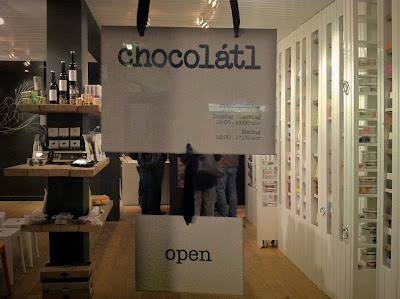Last night I spent the evening with a group of ladies sampling chocolate. Not a bad way to spend a Thursday night.
Chocolátl is a beautiful little shop located at Hazenstraat 25. The owners, Leslie and Eric (whom I later found out are from Portland), spent the evening teaching us all about chocolate. Or at least some of the basics. I retained enough info to now think I know something about chocolate...but I'm in no hurry to test my skills/knowledge on a real chocolate connoisseur.
Some things I learned:
How to taste: You start by looking at the chocolate. Look at the color and texture. Is it smooth and consistent? Then break the piece and check the color/texture within. And smell the chocolate. When you pop it in your mouth, let it sit on your tongue and allow your taste buds to experience all the flavors from the beginning, middle, and end. Very similar to wine tasting.
A little something about percentages: I learned that the percentage doesn't really mean a whole lot. It sounds like an accurate description of how much chocolate is in your bar, but it isn't necessarily. Within that percentage, part of it is cocoa, and the other part is the cocoa butter. So, say you have a 75% chocolate bar...some portion of that is actually cocoa butter. The ratio of cocoa butter to cocoa does not have industry set standards. So, you could have two bars (from different makers) with 75% chocolate, but the two bars actually will have different amounts of cocoa in them. The 75% definitely gives you something of a marker, but isn't an exact measurement of the pure cocoa. I hope that was a fairly accurate description...
Chocolate-Makers vs. Chocolatiers: Chocolate-Makers create chocolate straight from the bean. Many chocolate-makers also roast their own beans. Chocolatiers, on the other hand, create their chocolate masterpieces from existing chocolate.
Environment: Most cocoa beans in the world are grown in the belt 20 degrees above and below the equator.
The bean: Cocoa beans grow in a pod. You crack open the pod, and will find around 40 seeds within. At this stage, they get roasted. Once you crack the seed open, you have the small amount of cocoa within that they use to make the chocolate. At this raw form, there is no sugar in the cocoa (or at least none that humans can taste), and is not sweet at all.
All right, enough jibber-jabber. Lets look at some pictures!
Leslie & Eric:
Guinea Pigs:
Some of what we sampled:
The large roasted seeds, and it's form after you crush it:
The store is beautiful. I want a wall of these shelves in my house:
Thank you Brea for organizing!






















Malia, this is fantastic and great photos you took! thanks you so much for registering such great experience! I thought we were just going to taste chocolate!!!!
ReplyDeletewhat did I know??!! This experience did change my all perpective about the chocolate world!
And what a great group and hosts we had!!!
Looking forward for the next experience! Brea has set the bar! :)